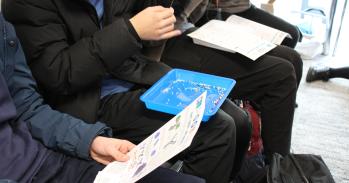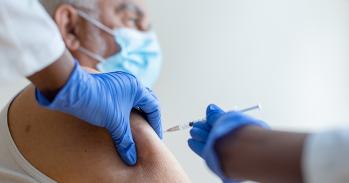
UK schools have received more than 300,000 CO2 monitors as part of a government initiative to reduce COVID-19 spread in classrooms.
UK schools have received more than 300,000 CO2 monitors as part of a government initiative to reduce COVID-19 spread in classrooms.
The monitors empower teachers to strike a balance between good ventilation and warmth during winter
Paul Linden
Scientists from Cambridge, Surrey and Imperial College London are supporting the rollout of portable monitors to UK schools as part of project CO-TRACE. The researchers behind the collaboration have produced materials to help teachers use the monitors, which have been rolled out to schools nationwide.
The level of carbon dioxide (CO2) in a closed space is a good indicator of air quality and can signpost the need for ventilation. As the virus that causes COVID-19 is airborne, ensuring the air is properly refreshed using ventilation is crucial for reducing its spread. The device displays levels of CO2 and colour coding to indicate good, normal, or poor ventilation. Well ventilated spaces should have CO2 levels consistently below 800 parts per million (ppm), with readings above 1500ppm indicating poor ventilation or overcrowding.
“CO2 monitors allow teachers to assess the ventilation in their classrooms for the first time,” said Imperial’s Dr Henry Burridge, co-investigator on the project. “This is especially important during colder months when ventilation is typically lower due to colder outdoor temperatures, causing COVID-19 and other airborne diseases like the common cold and flu to linger and spread more easily.”
The monitors mean teachers can see CO2 levels change in real-time as windows are opened and air is refreshed, allowing them to balance ventilation and warmth. Teachers can also use the monitors to know when it is safe to close windows slightly, which could help them keep classrooms more comfortable. As well as being a good ‘proxy’ for ventilation, lower CO2 levels have been linked to improved learning outcomes and better cognitive performance.
The team behind the CO-TRACE project uses experimental modelling, numerical simulations, full-scale observations, and infection risk modelling to understand how the potential for COVID-19 spread changes with indoor air flows, ventilation levels, and the number of people in a space. In 2021, the researchers used monitored CO2 to indicate how much exhaled breath was present within classrooms, and their models found that seasonal variation in classroom ventilation levels could lead to airborne infection risks in winter being roughly double those in summer. This highlights that monitoring excess CO2 could be of significant benefit in mitigating airborne infection risk.
The portability of the CO2 monitors, supplied by the Department for Education (DfE), means schools can move them around to test different areas, starting with those they suspect may be poorly ventilated.
“The monitors empower teachers to strike a balance between good ventilation and warmth during winter,” said Professor Paul Linden from Cambridge’s Department of Applied Mathematics and Theoretical Physics, co-investigator on the programme. “We are pleased that the Government is taking evidence-based action to address air quality and COVID-19 spread in schools.”
The monitors are accompanied by advice from the project which guides appropriate actions from teacher based on the CO2 readings in classrooms. Recommendations include opening higher windows before lower ones, and closing windows slowly when ventilation is good.
Schools with areas that are consistently low in air quality despite ventilation should consider using air cleaners. For such schools, the DfE is distributing between 7,000 and 8,000 air cleaning units.
When the project was announced in 2021, then-Education Secretary Gavin Williamson said: “Providing all schools with CO2 monitors will help them make sure they have the right balance of measures in place, minimising any potential disruption to education and allowing them to focus on world-class lessons and catch up for the children who need it. By keeping up simple measures such as ventilation and testing, young people can now enjoy more freedom at school and college.”
The project is funded by the EPSRC, part of UK Research and Innovation (UKRI).
Adapted from an Imperial College story.

The text in this work is licensed under a Creative Commons Attribution 4.0 International License. Images, including our videos, are Copyright ©University of Cambridge and licensors/contributors as identified. All rights reserved. We make our image and video content available in a number of ways – as here, on our main website under its Terms and conditions, and on a range of channels including social media that permit your use and sharing of our content under their respective Terms.




